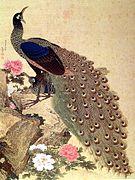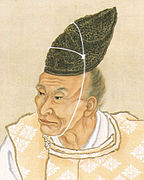Maruyama Shijō School
The Maruyama Shijō School ( Japanese 円 山 ・ 四条 派 Maruyama-Shijō-ha ), named for its important representatives, Maruyama Ōkyo and Shijō, named after the 4th Great East-West Street in Kyoto because of their studios, founded one in the 18th century Western-realistic representation within Japanese painting.
introduction
Until the 17th century, Japanese painting was characterized by an independent Japanese development: the Yamato-e and Tosa schools on the one hand and by a style that was determined by the Chinese influence, represented by the Kanō school .
After the Shogun around 1710 allowed the study of Western books (insofar as they had no Christian content), artists such as Maruyama Ōkyo (1730–1795) and Matsumura Gekkei (1752–1811), who signed as Goshun , based themselves on examples of Western painting, the had reached Japan via the Dutch branch Dejima in Nagasaki . The Kishi school, with Ganku (1749–1839) as the founder, also belongs to this direction.
To style
While Japanese painting emphasized the surface and renounced light and shadow until the 18th century, Maruyama - inspired by illustrations in the now accessible western books - strived for a more realistic representation. This included the depiction of the depth perspective in so-called glasses pictures ( 眼鏡 絵 megane-e ), for which Dutch peep boxes were also used.
Another impetus came from the further development of conventional herbalism ( 本草 学 honzō-gaku ) with its close connection to the healing of diseases and general botany, i.e. the recording of all plants in their individuality, also through realistic painterly depiction.
The schools
Maruyama's students included his son Ōzui ( 丸山 応 瑞 ; 1766–1829), his most talented successor Nagasawa Rosetsu , Komai Genki ( 駒 井 源 琦 ; 1747–1797), Watanabe Nangaku ( 渡 辺 南嶽 ; 1767–1813), Mori Tetsuzan ( 森徹 山 ; 1775–1841), Nishiyama Nantei ( 西山 楠 亭 ; 1775–1834), Yamaguchi Soken ( 山口 素 絢 ; 1759–1818), Yoshimura Kōkei ( 吉 村 孝敬 ; 1769–1836), Oku Bummei ( 奥 文 鳴 ; 1773–1813), the monk Gessen ( 月僊 ; 1741–1809), Yamaato Kakurei ( 山 跡 鶴 嶺 ; life dates unknown) and others.
The Shijō school includes Matsumura Gekkei , who also called himself simply Goshun ( 呉 春 ) in the Chinese style . He was one of the best students of Yosa Buson , but then joined the Maruyama direction. His younger half-brother Matsumura Keibun , Shibata Gitō ( 柴 田 義 董 ; 1780–1819), Okamoto Toyohiko ( 岡本 豊 彦 ; 1773–1845), Oda Kaisen ( 小田 海 僊 ) and others also belong to it .
In addition to the founder, Ganku ( 岸 駒 ), his son, Gantai ( 岸 岱 ), his grandson Renzan ( 連山 ) and other successors belong to the Kishi school .
photos
Okyo: Sliding Doors ( Kotohira Shrine )
literature
- Théo Lésoualc'h: The Japanese Painting. 25th volume in the series World History of Painting. Editions Rencontre, Lausanne 1968.




